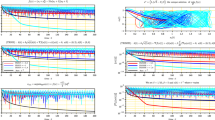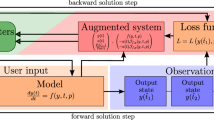Abstract
In this article, we consider an optimization problem where the objective function is evaluated at the fixed-point of a contraction mapping parameterized by a control variable, and optimization takes place over this control variable. Since the derivative of the fixed-point with respect to the parameter can usually not be evaluated exactly, an adjoint dynamical system can be used to estimate gradients. Using this estimation procedure, the optimization algorithm alternates between derivative estimation and an approximate gradient descent step. We analyze a variant of this approach involving dynamic time-scaling, where after each parameter update the adjoint system is iterated until a convergence threshold is passed. We prove that, under certain conditions, the algorithm can find approximate stationary points of the objective function. We demonstrate the approach in the settings of an inverse problem in chemical kinetics, and learning in attractor networks.



Similar content being viewed by others
References
Almeida, L.B.: A learning rule for asynchronous perceptrons with feedback in a combinatorial environment. In: IEEE First International Conference on Neural Networks, San Diego, California. IEEE, New York (1987)
Pineda, F.J.: Generalization of back-propagation to recurrent neural networks. Phys. Rev. Lett. 59, 2229–2232 (1987)
Atiya, A.F.: Learning on a general network. In: Anderson, D.Z. (ed.) Neural Information Processing Systems, pp. 22–30. American Institute of Physics (1988)
Pineda, F.J.: Dynamics and architecture for neural computation. J. Complex. 4(3), 216–245 (1988)
Pineda, F.J.: Recurrent backpropagation and the dynamical approach to adaptive neural computation. Neural Comput. 1(2), 161–172 (1989)
Riaza, R., Zufiria, P.J.: Differential-algebraic equations and singular perturbation methods in recurrent neural learning. Dynamical Systems: An International Journal 18(1), 89–105 (2003)
Chris Tseng, H., Šiljak, D.D.: A learning scheme for dynamic neural networks: Equilibrium manifold and connective stability. Neural Netw. 8(6), 853–864 (1995)
Lohmiller, W., Slotine, J.-J.E.: On contraction analysis for non-linear systems. Automatica 34(6), 683–696 (1998)
Flynn, T.: Timescale separation in recurrent neural networks. Neural Comput. 27(6), 1321–1344 (2015)
Younes, L.: On the convergence of markovian stochastic algorithms with rapidly decreasing ergodicity rates. Stochastics: An International Journal of Probability and Stochastic Processes 65(3-4), 177–228 (1999)
Tieleman, T.: Training restricted boltzmann machines using approximations to the likelihood gradient. In: Proceedings of the 25th International Conference on Machine Learning, pp. 1064–1071. ACM (2008)
Hornik, K., Kuan, C.-M.: Gradient-based learning in recurrent networks. Neural Netw. World 4, 157–172 (1994)
Giles, M.B., Pierce, N.A.: An introduction to the adjoint approach to design. Flow Turbul. Combust. 65(3-4), 393–415 (2000)
Peter, J.E.V., Dwight, R.P.: Numerical sensitivity analysis for aerodynamic optimization: a survey of approaches. Comput. Fluids 39(3), 373–391 (2010)
Giles, M.: On the iterative solution of adjoint equations. In: Corliss, G., Faure, C., Griewank, A., Hascoët, L., Naumann, U. (eds.) Automatic Differentiation of Algorithms, pp 145–151. New York, Springer (2002)
Ta’asan, S.: One shot methods for optimal control of distributed parameter systems i: Finite dimensional control. Technical report, Institute for Computer Applications in Science and Engineering (ICASE), Hampton VA (1991)
Hazra, S.B., Jameson, A.: One-shot pseudo-time method for aerodynamic shape optimization using the navier–stokes equations. Int. J. Numer. Methods Fluids 68(5), 564–581 (2012)
Günther, S., Gauger, N.R., Wang, Q.: Simultaneous single-step one-shot optimization with unsteady {PDEs}. J. Comput. Appl. Math. 294, 12–22 (2016)
Jaworski, A., Cusdin, P., Muller, J.-D.: Uniformly converging simultaneous time-stepping methods for optimal design. In: Schilling, R., Haase, W., Periaux, J., Baier, H., Bugeda, G. (eds.) Evolutionary and Deterministic Methods for Design, Optimization and Control with Applications to Industrial and Societal Problems (EUROGEN) (2005)
Hamdi, A., Griewank, A.: Reduced quasi-newton method for simultaneous design and optimization. Comput. Optim. Appl. 49(3), 521–548 (2011)
Flynn, T.: Convergence of one-step adjoint methods. In: Proceedings of the 22nd International Symposium on Mathematical Theory of Networks and Systems (2016)
Bertsekas, D.P., Tsitsiklis, J.N.: Gradient convergence in gradient methods with errors. SIAM J. Optim. 10(3), 627–642 (2000)
Nesterov, Y.: Introductory lectures on convex optimization: a basic course, vol. 87. Springer Science & Business Media (2013)
Baldi, P.: Gradient descent learning algorithm overview: a general dynamical systems perspective. IEEE Trans. Neural Netw. 6(1), 182–195 (1995)
Russo, G., Di Bernardo, M., Sontag, E.D.: Global entrainment of transcriptional systems to periodic inputs, vol. 6 (2010)
Sontag, E.D.: Contractive systems with inputs. In: Perspectives in Mathematical System Theory, Control, and Signal Processing, pp. 217–228. Springer (2010)
Gnacadja, G.: Fixed points of order-reversing maps in \(\mathbb {R}_{n > 0}\) and chemical equilibrium. Math. Methods Appl. Sci. 30(2), 201–211 (2007)
van Dorp, M. G. A., Berger, F., Carlon, E.: Computing equilibrium concentrations for large heterodimerization networks. Phys. Rev. E 84, 036114 (2011)
Anderson, D.F., Kurtz, T.G.: Stochastic Analysis of Biochemical Systems. Springer, Berlin (2015)
Horn, R.A., Johnson, C.R. (eds.): Matrix Analysis. Cambridge University Press, New York (1986)
Funding
This research was supported, in part, under the National Science Foundation Grants CNS-0958379, CNS-0855217, and ACI-1126113; the City University of New York High Performance Computing Center at the College of Staten Island; the United State Department of Energy contract DE-SC0012704; and DOE Office of Science under grant ASCR KJ040201.
Author information
Authors and Affiliations
Corresponding author
Additional information
Publisher’s note
Springer Nature remains neutral with regard to jurisdictional claims in published maps and institutional affiliations.
Rights and permissions
About this article
Cite this article
Flynn, T. A persistent adjoint method with dynamic time-scaling and an application to mass action kinetics. Numer Algor 89, 87–113 (2022). https://doi.org/10.1007/s11075-021-01107-8
Received:
Accepted:
Published:
Issue Date:
DOI: https://doi.org/10.1007/s11075-021-01107-8




